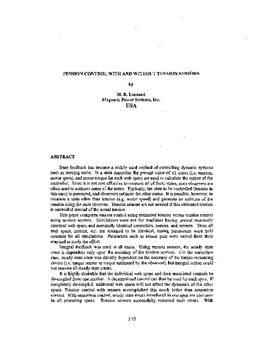| dc.contributor.author | Leonard, M. R. | |
| dc.contributor.other | International Conference on Web Handling (1999) | |
| dc.date.accessioned | 2019-11-07T15:30:20Z | |
| dc.date.available | 2019-11-07T15:30:20Z | |
| dc.date.issued | 1999-06 | |
| dc.identifier | oksd_icwh_1999_leonard | |
| dc.identifier.citation | Leonard, M. R. (1999, June). Tension control with and without tension sensors. Paper presented at the Fifth International Conference on Web Handling (IWEB), Stillwater, OK. | |
| dc.identifier.uri | https://hdl.handle.net/11244/321782 | |
| dc.description.abstract | State feedback has become a widely used method of controlling dynamic systems such as moving webs. In a state controller the present value of all states (i.e. tension, motor speed, and motor torque for each web span) are used to calculate the output of the controller. Since it is not cost effective to measure all of these states, state observers are often used to estimate some of the states. Typically, the state to be controlled (tension in this case) is measured, and observers estimate the other states. It is possible, however, to measure a state other than tension (e.g. motor speed) and generate an estimate of the tension using the state observer. Tension sensors are not needed if this estimated tension is controlled instead of the actual tension. | |
| dc.description.abstract | This paper compares tension control using estimated tension versus tension control using tension sensors. Simulations were run for machines having several nominally identical web spans and nominally identical controllers, motors, and sensors. Since all web spans, motors, etc. are assumed to be identical, tuning parameters were held constant for all simulations. Parameters such as sensor gain were varied from their nominal to study the effect. | |
| dc.description.abstract | Integral feedback was used in all cases. Using tension sensors, the steady state error is dependent only upon the accuracy of the tension sensors. For the sensorless case, steady state error was directly dependent on the accuracy of the torque-measuring device (i.e. torque sensor or torque estimated by the observer), but integral action could not remove all steady state errors. | |
| dc.description.abstract | It is highly desirable that the individual web spans and their associated controls be de-coupled from one another. A decentralized control can then be used for each span. If completely de-coupled, additional web spans will not affect the dynamics of the other spans. Tension control with sensors accomplished this much better than sensorless control. With sensorless control, steady state errors introduced in one span are also seen in all preceding spans. Tension sensors successfully removed such errors. With sensorless control adding more web spans (and their associated controls) eventually resulted in an unstable system. This was not observed using tension sensor control. | |
| dc.description.abstract | A robust system is one that can tolerate large changes in parameters. Here again, for most parameters control with tension sensors was superior to sensorless control. | |
| dc.format | application/pdf | |
| dc.language | en_US | |
| dc.publisher | Oklahoma State University | |
| dc.rights | In the Oklahoma State University Library's institutional repository this paper is made available through the open access principles and the terms of agreement/consent between the author(s) and the publisher. The permission policy on the use, reproduction or distribution of the article falls under fair use for educational, scholarship, and research purposes. Contact Digital Resources and Discovery Services at lib-dls@okstate.edu or 405-744-9161 for further information. | |
| dc.title | Tension control with and without tension sensors | |
| osu.filename | oksd_icwh_1999_leonard.pdf | |
| dc.type.genre | Conference proceedings | |
| dc.type.material | Text | |
